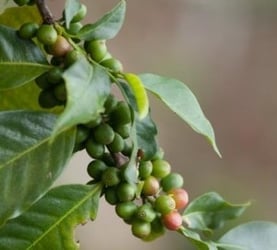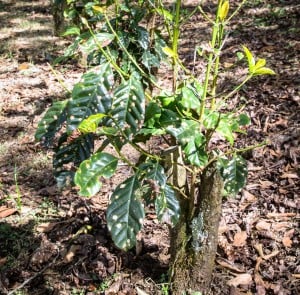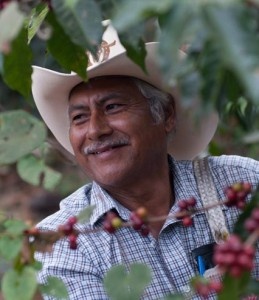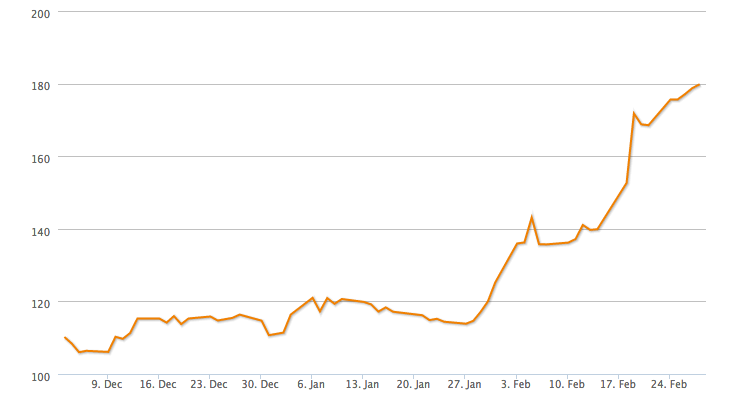Volatility in the C-market is not a new occurrence, but in recent weeks the market has seen an unprecedented upsurge in an astoundingly short time period. During the week of Feb. 24, Arabica reached $1.80 per pound, its highest price in 16 months. But one month earlier, the Arabica price was just $1.14.
C-Market Arabica prices from 12/3/13 - 3/3/14. Source: The Intercontinental Exchange.
What spurred this extremely fast rise? Simply put: Dry weather conditions in Brazil, the world’s largest producer of Arabica coffee. Like any coffee-producing country, Brazil has well-defined wet and dry seasons, and this time of year is typically one of heavy rains that fade in April as Brazilian farmers begin harvesting coffee. But Brazil is currently experiencing its worst drought in decades. The patterns have caused many of us who work on the financial side of coffee to read weather reports as much as we read market reports.
 Unfortunately, the drought comes at a time that is potentially critical for development, with the coffee beans finishing their maturation cycle inside the cherries. The coffee world won’t know the actual repercussions of the weather until harvest season, but many are bracing for underweight, underdeveloped beans, also known as quakers. These fears have prompted speculation on what the Brazilian crop will look like, and because that crop drives the global market, the Arabica price has responded accordingly. By shooting up, the market is essentially ”pricing in” a sizable potential crop loss—if output is down, the higher prices will make up for some of that shortfall.
Unfortunately, the drought comes at a time that is potentially critical for development, with the coffee beans finishing their maturation cycle inside the cherries. The coffee world won’t know the actual repercussions of the weather until harvest season, but many are bracing for underweight, underdeveloped beans, also known as quakers. These fears have prompted speculation on what the Brazilian crop will look like, and because that crop drives the global market, the Arabica price has responded accordingly. By shooting up, the market is essentially ”pricing in” a sizable potential crop loss—if output is down, the higher prices will make up for some of that shortfall.
 And Brazil isn’t the only producing country looking at reduced output. Though Central American countries don’t drive the market the same way Brazil does, many are seeing greatly reduced numbers at the hands of Coffee Rust Disease, or Roya. Coffee exports in El Salvador, for example, are expected to fall by nearly 60 percent from last harvest, according to the Salvadoran Coffee Council, while Guatemala, Costa Rica, Honduras, and Mexico are each reporting reduced coffee output by 20 percent or more.
And Brazil isn’t the only producing country looking at reduced output. Though Central American countries don’t drive the market the same way Brazil does, many are seeing greatly reduced numbers at the hands of Coffee Rust Disease, or Roya. Coffee exports in El Salvador, for example, are expected to fall by nearly 60 percent from last harvest, according to the Salvadoran Coffee Council, while Guatemala, Costa Rica, Honduras, and Mexico are each reporting reduced coffee output by 20 percent or more.
For roasters, these developments are undoubtedly worth tracking. While the Brazilian drought doesn’t necessarily equate to a global coffee shortage, it’s certainly affecting the market price that translates directly to roasters’ bottom lines. And the Roya crisis is helping to shorten supply even further.
 The changing market will likely transform roasters’ coffee-buying habits. Ever-declining markets in recent years have allowed roasters to be passive buyers, with low prices and quality coffees constantly available. But with that availability tightening, my advice to roasters is to start booking your coffees earlier than you usually do. Not only will this guarantee your access to the coffees you need to run your business, but it will show a clear signal to suppliers that they matter most. This is a practice we encourage through Sustainable Harvest’s® inclusive Relationship Coffee Model, where all links of the chain work together to ensure a sustainable coffee supply.
The changing market will likely transform roasters’ coffee-buying habits. Ever-declining markets in recent years have allowed roasters to be passive buyers, with low prices and quality coffees constantly available. But with that availability tightening, my advice to roasters is to start booking your coffees earlier than you usually do. Not only will this guarantee your access to the coffees you need to run your business, but it will show a clear signal to suppliers that they matter most. This is a practice we encourage through Sustainable Harvest’s® inclusive Relationship Coffee Model, where all links of the chain work together to ensure a sustainable coffee supply.
It’s true that no one knows exactly what this year’s Brazilian coffee harvest will look like, but some level of reduced output is a near certainty. Almost as certain is that market volatility will continue, as dry weather, Roya, and other signs of climate change continue to wreak havoc. We as a supply chain must continue to work closely and transparently to ensure that all sides are protected as we face the challenges posed by a market full of uncertainty.




.png)
